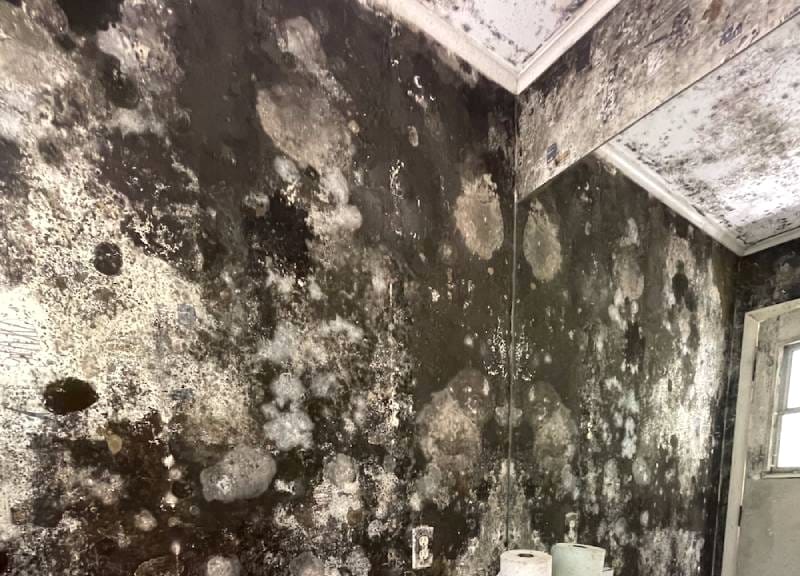Black mold (Stachybotrys chartarum) has a distinct smell and its smell is usually one of the first signs homeowners notice, well before ever seeing visible black mold growth.
Unlike many other molds, black mold gives off a particularly noticeable and strange smell—and for a specific reason.
Black mold gives off a musty, earthy or damp smell, quite similar to rotting wood, wet socks, or decaying leaves.
This smell may or may not be consistent throughout your entire house. It may be that you only get rare whiffs of it, such as when you’re closest to where the black mold is growing, or when air currents shift within your house—the garage door opens and a gust of wind comes in for example.
If you’ve never been in a forest or have trouble envisioning what “musty, earthy or damp” actually smells like, here are some clues to help you more definitively answer whether you might have a black mold problem.
#0 — To be clear, if you suspect black mold, please spend as little time smelling it as possible.
Along with the smell of black mold comes particulate matter smaller than mold spores. Called mycotoxins, these are one of mold’s defense mechanisms. They’re not good for you and research suggests (EPA.GOV) they can end up in your blood stream or body, and cause health problems. So you’ll want to spend as little time in the area where you believe black mold is growing until you know for sure that it isn’t.
#1 — Black Mold isn’t always a bad or putrid smell, it can actually smell sweet at times.
If you’ve heard about the possible dangers of being in range of black mold for long periods of time, you’d probably imagine that it gives off deathly, vile, or highly-toxic smells. Except, it actually doesn’t.
Gusts of air that pick up the smell of black mold can actually come across as pleasant or sweet smelling. If you’ve ever been in an aged home or cottage, you might have noticed a sort of background smell, one that seems to have a charm or nostalgia for lack of a better word.
Whether you enjoy the smell or find it repulsive has a lot to do with the concentration of mVOCs in the air at the time. In the early morning, you might find the smell slightly pleasant; while in the evening it might offend you or smell like wet socks—these are different degrees or concentrations of mVOCs in the air, affected by the temperature, indoor air circulation, and the outdoor’s weather. Hard to explain a smell, harder yet to explain the smell of black mold, but you probably get the idea: Black mold doesn’t always smell like death or rot.
Next, consider the source of the smell: Where in the house does it smell most? Black mold needs higher than normal amounts of moisture and dampness so consider whether you had a recent leak or flood.
#2 — Black Mold needs more water or moisture than the ‘Average Mold’ does in order to grow.
One of the reasons black mold smells as it does is because it requires more water and moisture than the “average mold” needs to grow. Black mold is considered a “wet mold” so it’s likely to show up in areas where water damage alone is also a problem—you’ll get rotting wood, wet carpeting or sub flooring, etc., which has been wet for more than a few days. The faster it’s dried up and removed the better. But that fact should help you narrow down whether you have a black mold problem and if so, where it is. (Don’t DIY your own black mold removal though; done wrong, you’ll amplify the problem.)
A recent leak, long-term pipe leak, flood water, etc., are all likely to be at the root of a black mold problem. Another less common and probably worse cause is greatly elevated humidity, because that’s not something many people would suspect. In Florida, it’s a problem, and if it gets bad enough, black mold might be one of the side effects. Running your A/C is key, and having an A/C sized to fit your home is important. And A/C that’s too big is a bad A/C as far as mold is concerned.
What Black Mold Smells Like
Black mold typically gives off a:
- Musty, earthy, or damp odor, similar to rotting wood, wet socks, or decaying leaves.
- The smell can be stronger in enclosed or humid areas such as bathrooms, basements, attics, or behind drywall.
- It may stick around even after cleaning, if the source of moisture isn’t found and fixed.
Why the Smell Matters
That musty odor indicates active mold growth and moisture problems. Mold releases microbial volatile organic compounds (mVOCs) that are the cause of the odor, and these compounds can also irritate your eyes, nose, and throat, even if you can’t see mold.
What to Do If You Suspect Mold
If you notice a persistent musty smell in your home:
- Inspect common problem areas, like under sinks, around windows, in HVAC systems, and near recent leaks.
- Avoid disturbing or touching visible mold, as that will only release more mold spores.
- Call a licensed and certified mold inspector or mold remediation company. They’ll use moisture meters, take air samples, or use a specially-trained dog to find out if mold is actually the problem.
Mold is a tough topic at times, with some people taking advantage of the fear around mold or of the urgency of addressing it after hurricanes. That’s why Florida and other states have laws in place to protect consumers. In Florida, mold remediation companies have to be licensed by the state and insured, and they can’t do both the inspection for mold and the mold remediation itself. Two different companies have to do these things.
Common Molds and How They Smell
1. Black Mold (Stachybotrys chartarum)
Smell:
- Strong, musty, and earthy; often described as rotting wood, wet soil, damp basement, or decaying leaves.
- Some people say it smells “thicker” or “heavier” than other mold odors—almost slimy or stale, because Stachybotrys chartarum grows on wet cellulose materials (like drywall, wood, paper, or insulation) and produces mycotoxins and microbial volatile organic compounds (mVOCs).
- The smell can be persistent, even after cleaning, if the underlying moisture source remains.
Why it smells this way:
- Black mold develops in consistently damp, water-damaged areas.
- It feeds on organic materials (like paper backing on drywall), releasing mVOCs, which are compounds known for their earthy, moldy, mushroom-like aroma.
- The odor tends to be more pungent and less “airy” than other molds.
2. Common Household Molds (e.g., Aspergillus, Cladosporium, Penicillium)
Smell:
- Often musty or damp, but lighter, sharper, or slightly sweet compared to black mold.
- Some species have a metallic, fermented, or even cheesy smell.
- The scent may come and go depending on humidity and air circulation.
Why it smells like that:
- These molds can grow on a wider range of surfaces — fabrics, food, window sills, HVAC systems, etc.
- They don’t require as much moisture as black mold, so their odor is usually less intense and more transient.
- The smell can vary by species and substrate. For example, Penicillium may smell slightly fruity or musty, Cladosporium can smell oily or earthy, Aspergillus sometimes smells sweet or nutty.
3. Mildew (usually a type of surface mold, often Oidium or Penicillium)
Smell:
- Light, stale, and powdery smell, similar to damp laundry left in the washer or musty paper.
- Not as deep or earthy as mold odors.
- Often described as “old basement” or “stuffy closet” smell.
Why it smells like that:
- Mildew is typically surface-level and grows in humid but not soaked environments like bathroom tiles, shower curtains, or window sills.
- It doesn’t penetrate materials deeply, so the odor is less potent and easier to remove with cleaning and ventilation.
Mold Smells Compared
| Type | Commonly Found | Smell | Intensity | Notes |
|---|---|---|---|---|
| Black Mold (Stachybotrys chartarum) | Behind drywall, under carpets, around leaks | Heavy, earthy, rotting wood, wet soil | Strong | Indicates serious moisture problem. |
| Common Household Mold (Aspergillus, Cladosporium, etc.) | HVAC, fabrics, food, window sills | Musty, slightly sweet, metallic, or nutty | Moderate | Comes and goes with humidity. |
| Mildew | Bathrooms, shower curtains, paper, fabrics | Light, stale, damp laundry smell | Mild | Surface-level and usually easily cleaned. |
What to Do About Black Mold
In short, black mold should be found and removed and as quickly as possible. You should spend as little time as possible in an area affected by black mold or any mold really.
The professional opinion of government agencies, like the U.S. EPA, is that it doesn’t quite matter what specific type of mold is present. Their position is that all visible mold should simply be removed, and that testing isn’t needed because no safe level of mold has been established anyway.
But, we suggest mold testing if you’re concerned about mold in your house, or if insurance or legal professionals are going to be involved. And in all cases, we suggest proper mold remediation if mold is ever a problem.
If you live in Tampa, Clearwater, or any of the surrounding cities, Mold Solutions will be happy to lend its experience and certification, and provide you a free environmental consultation.







